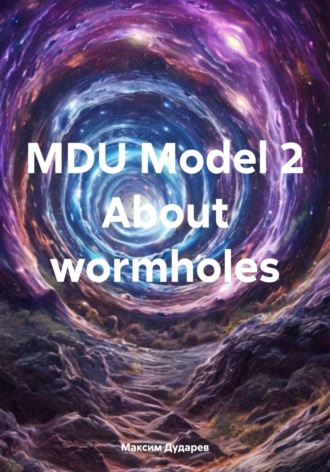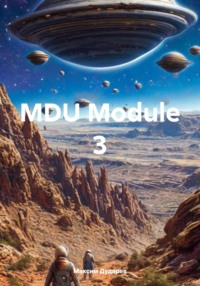
Полная версия
MDU Model 2 About wormholes

Максим Дударев
MDU Model 2 About wormholes
Wormholes: A Journey Through the Universe
Author: Maxim Dudaev, Moscow
Chapter 1: What Are Wormholes?
Wormholes, often referred to as "bridges" or "tunnels" in the fabric of spacetime, are theoretical passages that connect disparate points in the universe. They arise from solutions to the Einstein field equations of general relativity. A wormhole can be envisioned as a tunnel-like structure with two ends, each situated at different locations in space and time. Some scientists propose that wormholes could provide shortcuts for interstellar travel, allowing us to bypass the vast distances between stars. Imagine being able to travel from Earth to a distant galaxy in an instant! While this idea is fascinating, the practicality of such travel remains in the realm of speculation.
The concept of wormholes challenges our understanding of reality. They blur the lines between time and space, suggesting that the universe may be more interconnected than we previously thought. When we consider wormholes, we are venturing into the uncharted territory of theoretical physics. Some researchers believe that they could be formed by extreme gravitational fields, such as those produced by black holes.
Question: What defines a wormhole?
Answer: A wormhole is defined by its unique structure that connects two separate points in spacetime, allowing for shortcuts between these points. It consists of a "throat" connecting two "mouths," which can be located light-years apart. If these connections exist, they could revolutionize space travel as we know it.
Wormholes also raise profound philosophical questions about the nature of time and existence. If we can travel through these cosmic tunnels, what does that mean for our understanding of causality? Could traveling back in time lead to paradoxes? The idea of traversing through time as well as space opens up a plethora of theoretical implications. While the existence of wormholes remains unproven, they stimulate the imagination and challenge the boundaries of science. They inspire numerous scientific inquiries, pushing the frontiers of our knowledge.
As we delve deeper into the mysteries of the universe, wormholes will undoubtedly continue to be a focal point of research. They embody the intrigue of possibilities that lie beyond our current understanding of physics. Despite the challenges in proving their existence, the concept of wormholes ignites curiosity and excitement among scientists and enthusiasts alike.
Chapter 2: The Physics of Wormholes
The physics governing wormholes is rooted in general relativity and quantum mechanics. These structures rely on the concept of "exotic matter," which is hypothesized to possess negative energy density. The existence of such matter is critical for stabilizing a traversable wormhole, preventing it from collapsing under gravitational forces. Without exotic matter, the gravitational pull of a wormhole's mouth could crush anything attempting to enter it.
The concept of negative energy density might sound strange, but it is supported by various theoretical frameworks. Some physicists argue that quantum fluctuations could provide a source of exotic matter. The idea of manipulating such matter opens up new possibilities in our understanding of the universe. It invites us to think creatively about how we might interact with the fundamental forces of nature.
Question: How does general relativity relate to wormholes?
Answer: General relativity describes how mass and energy warp spacetime. Wormholes emerge as solutions to Einstein's field equations, which depict how gravitational fields can create paths that allow for faster-than-light travel under certain conditions. The implications of this theory are profound, suggesting that spacetime can be manipulated in ways we are only beginning to comprehend.
This equation shows the relationship between geometry (left side) and energy/matter (right side). Understanding these equations is essential for grasping how wormholes function within the framework of modern physics.
Additionally, the study of wormholes raises important questions about the nature of spacetime itself. Are these structures a mere theoretical construct, or do they have real-world implications? As we explore the physics of wormholes, we must consider both the mathematical frameworks and the potential experimental validations. This dual approach enriches our understanding and invites further exploration into the nature of the cosmos.
Wormholes challenge our existing paradigms and compel us to think outside the conventional boundaries of science. The intersection of quantum mechanics and general relativity offers a fertile ground for new theories and discoveries. As scientists continue to investigate the nature of wormholes, we may unlock new secrets of the universe and enhance our understanding of its fundamental workings.
Chapter 3: Traveling Through a Wormhole
How would traveling through a wormhole feel? Scientists theorize that it could resemble entering a tunnel, with spacetime warping around the traveler. The journey might be instantaneous, but it could also involve strange effects like time dilation or gravitational forces affecting the traveler differently. The idea of instantaneously crossing vast distances is both exhilarating and daunting.
Question: What physical effects could occur while traveling through a wormhole?
Answer: Travelers might experience tidal forces, causing different parts of their bodies to be subjected to varying gravitational pulls. Time dilation could also occur, where time for the traveler passes differently compared to an observer outside the wormhole. This could lead to situations where a traveler ages differently than people who remained in the original location.
The experience of traversing a wormhole may also be accompanied by visual phenomena, such as distorted light patterns or changes in perception of time and space. Imagine entering a swirling tunnel of light, where the very fabric of reality shifts and bends around you. While this sounds fascinating, the physiological effects of such travel remain largely speculative. Scientists must consider the potential risks and challenges of this form of transportation.
Additionally, there are numerous technical hurdles to overcome before such travel could be realized. For instance, creating and maintaining a stable wormhole would require advanced technology far beyond our current capabilities. The engineering challenges involved in manipulating exotic matter and controlling gravitational fields are monumental.
As we imagine the possibilities of traveling through wormholes, we must also contemplate the ethical implications of such technology. What responsibilities would we hold as explorers of new worlds? How would we interact with potential extraterrestrial civilizations? These questions are vital to the discourse surrounding the future of space travel.
In conclusion, while the idea of traveling through wormholes is captivating, it is accompanied by significant theoretical and practical challenges. Our understanding of the universe and the nature of spacetime must evolve as we explore the potential for such incredible journeys. The concept of wormhole travel invites us to dream, to innovate, and to ponder the future of humanity among the stars.
Chapter 4: Wormholes and Time Paradoxes
Traveling through wormholes might create time paradoxes, leading to scenarios like the grandfather paradox, where a traveler could theoretically prevent their own existence. This chapter will explore potential resolutions to these paradoxes, such as the multiverse theory. The very idea of manipulating time raises fundamental questions about causality and existence.
Question: What is the grandfather paradox?
Answer: The grandfather paradox occurs when a time traveler goes back in time and accidentally prevents their grandfather from meeting their grandmother. This raises questions about the consistency of timelines and whether changes in the past affect the future. If the traveler ceases to exist, what implications does that have for the timeline?
There are various theories that attempt to resolve this paradox. One possible resolution is the idea of branching timelines or parallel universes. According to this theory, any action taken in the past creates a new timeline, effectively allowing the original timeline to remain unaffected. This concept aligns with the multiverse theory, where every decision branches off into a separate universe.
Another approach to understanding these paradoxes involves the notion of self-consistency. This theory posits that any actions taken by a time traveler in the past were always part of history, meaning they could not change significant events. The implications of self-consistency suggest a predetermined timeline where paradoxes cannot occur.
Question: How do multiverses relate to time travel?
Answer: In a multiverse framework, every time a traveler makes a choice, a new universe branches off from the original timeline. This means that the actions of a time traveler could create alternative realities rather than alter the past in a single timeline. Each universe may follow a different set of rules or events, leading to infinite possibilities.
The exploration of time paradoxes challenges our understanding of reality and the nature of time itself. It compels us to reconsider what it means to travel through time and the potential consequences of our actions. As we delve deeper into these theories, we find ourselves grappling with philosophical questions about free will, destiny, and the fabric of existence.
In summary, the relationship between wormholes and time paradoxes invites rich theoretical discussions that transcend traditional scientific boundaries. As we explore these ideas, we expand our understanding of the universe and our place within it. The implications of time travel through wormholes may be more complex than we can currently imagine, yet they offer a fascinating glimpse into the potential of the cosmos.
Chapter 5: Are Wormholes Real?
While wormholes are largely theoretical, some scientists are investigating possible evidence for their existence. This chapter discusses various methods for detecting wormholes, including gravitational lensing and cosmic microwave background studies. The search for tangible evidence of wormholes is an ongoing endeavor in the field of astrophysics.
Question: What methods might scientists use to find wormholes?
Answer: Scientists could look for the gravitational effects of a wormhole on surrounding matter. Gravitational lensing, where light bends around massive objects, could provide indirect evidence of a wormhole's presence. By observing the light from distant stars and galaxies, astronomers can infer the presence of massive objects that may be hidden, such as wormholes.
Another potential method involves studying the cosmic microwave background radiation. This ancient radiation, a remnant from the Big Bang, holds clues about the early universe. If wormholes existed in the early universe, they could have influenced the distribution of this radiation. Anomalies in the cosmic microwave background could indicate the presence of such structures.
Question: Are there any theoretical frameworks supporting the existence of wormholes?
Answer: Yes, several theoretical frameworks, including general relativity and string theory, support the idea that wormholes could exist. These frameworks provide the mathematical underpinnings necessary to understand how wormholes might be formed and stabilized. Additionally, ongoing research in quantum gravity aims to reconcile the principles of quantum mechanics with general relativity, potentially shedding light on the nature of wormholes.
The search for evidence of wormholes raises intriguing questions about the nature of our universe. If wormholes do exist, what implications would that have for our understanding of space and time? The discovery of a wormhole would revolutionize our understanding of the cosmos and challenge our perceptions of reality.
While the existence of wormholes remains unproven, the pursuit of knowledge continues to inspire scientists and researchers around the world. As we explore the universe and our place within it, the search for wormholes will remain a crucial area of investigation in the quest for understanding the fundamental laws of physics.
In conclusion, the question of whether wormholes are real is still open for exploration. Theoretical frameworks and ongoing research provide exciting avenues for discovery, and the quest for evidence will continue to shape our understanding of the universe. As we delve deeper into the mysteries of spacetime, we may uncover the secrets that lie beyond our current comprehension. Chapter 6: Wormholes in Popular Culture
Конец ознакомительного фрагмента.
Текст предоставлен ООО «Литрес».
Прочитайте эту книгу целиком, купив полную легальную версию на Литрес.
Безопасно оплатить книгу можно банковской картой Visa, MasterCard, Maestro, со счета мобильного телефона, с платежного терминала, в салоне МТС или Связной, через PayPal, WebMoney, Яндекс.Деньги, QIWI Кошелек, бонусными картами или другим удобным Вам способом.




